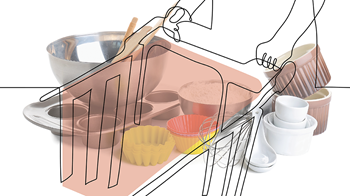This is the fifth blog from FMI's nonfoods in grocery stores series. We share compelling insights from our Power of Nonfoods research among shoppers and industry perspectives to explore nonfoods' role in the food retailing industry.
By: Tom Duffy, Senior Advisor, Industry Relations, FMI

It's not hard to form an emotional attachment to a kitchen gadget. For me, my old-fashioned, hand-crank cranberry grinder comes to mind. If you're unfamiliar, they resemble long-handled, cast-iron meat grinders that you clamp to a table or countertop, only the end product is cranberry sauce, not sausage.
Lately, it's become more of a display piece. If we want to grind cranberries, we can use a food processor. Thanksgiving will be a success no matter how you slice it (literally). Still, childhood memories of latching our cranberry grinder to the countertop and cranking that handle to grind the berries—not our fingers—are clear as a bell.
While pulverizing fruits doesn't play a big role in my life nowadays, put an ice cream scooper, wine bottle opener, or pizza slicer in front of me and you're guaranteed to get a smile—because I know something delicious is just around the corner.
These attachments may be why kitchen gadget purchases, including spatulas, pots and pans, are important. They're less frequent, but selection, quality, variety and unique products are key considerations.
Consumers will most likely be ramping up their gadget purchases this holiday season to assure success in their upcoming meal endeavors, making FMI's Power of Nonfoods report a valuable resource offering insights into this important market.
Here's a sneak peek of the research:
- While selection (31%), quality (35%), variety (30%), and unique products (18%) are more important to consumers than many other categories, low cost and best value still matter, at 38% and 40% respectively.
- Increased selectiveness may explain why 27% of consumers have switched where they buy kitchen gadgets in the last 12 months, with 18% buying more online.
- Seventy-two percent of consumers buy gadgets less than once a month. ("I don't always buy a pizza slicer, but when I do…") Thirty-five percent have made a purchase in the past 12 months.
- Mass retailers are the most common channels at 43% for these types of purchases. Eleven percent of purchases come from grocery stores.
- Fifty-five percent of the time, buying gadgets is part of normal shopping, but it's a special trip 27% of the time. ("Quick! We need an ice cream scooper!") Eighteen percent of the time, it's something the shopper adds on to another purchase.
- Fifty-seven percent of purchases are planned, which is lower than most other categories. Seventeen percent are impulse purchases, which is high compared to other categories.
When it comes to kitchen gadgets, my family certainly falls into the impulse purchase camp. As a matter of fact, just the other day, we bought an emulsion blender off an impulse purchase display—and we love it. Of course, it's no cranberry grinder, but building a lasting relationship with your gadget can take time.


 Industry Topics address your specific area of expertise with resources, reports, events and more.
Industry Topics address your specific area of expertise with resources, reports, events and more.
 Our Research covers consumer behavior and retail operation benchmarks so you can make informed business decisions.
Our Research covers consumer behavior and retail operation benchmarks so you can make informed business decisions.
 Events and Education including online and in-person help you advance your food retail career.
Events and Education including online and in-person help you advance your food retail career.
 Food Safety training, resources and guidance that help you create a company food safety culture.
Food Safety training, resources and guidance that help you create a company food safety culture.
 Government Affairs work — federal and state — on the latest food industry policy, regulatory and legislative issues.
Government Affairs work — federal and state — on the latest food industry policy, regulatory and legislative issues.
 Get Involved. From industry awards to newsletters and committees, these resources help you take advantage of your membership.
Get Involved. From industry awards to newsletters and committees, these resources help you take advantage of your membership.
 Best practices, guidance documents, infographics, signage and more for the food industry on the COVID-19 pandemic.
Best practices, guidance documents, infographics, signage and more for the food industry on the COVID-19 pandemic.
